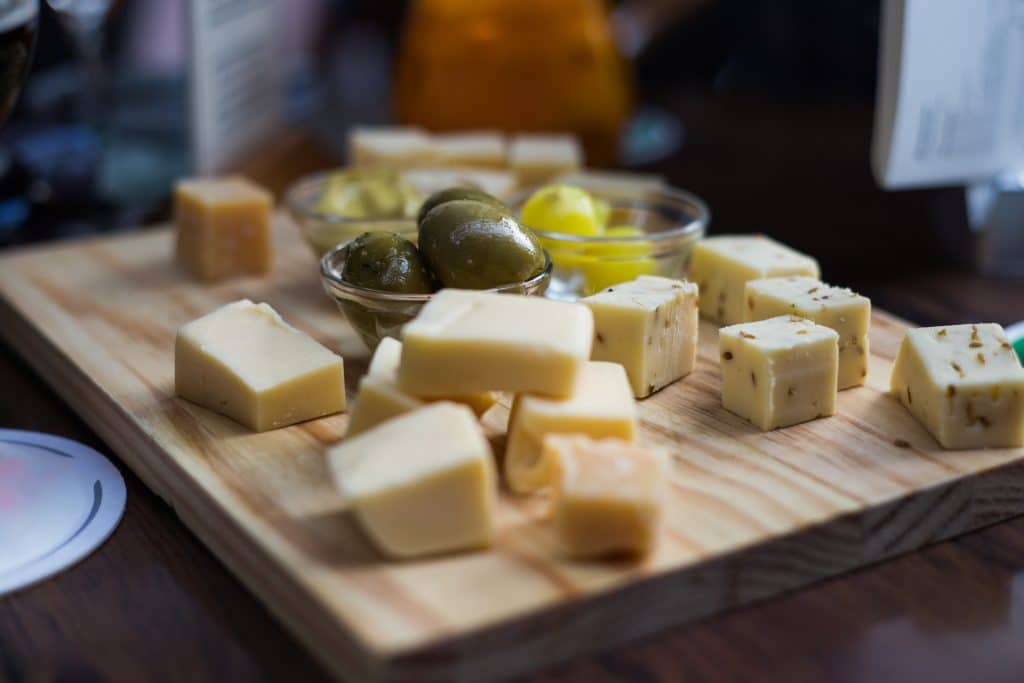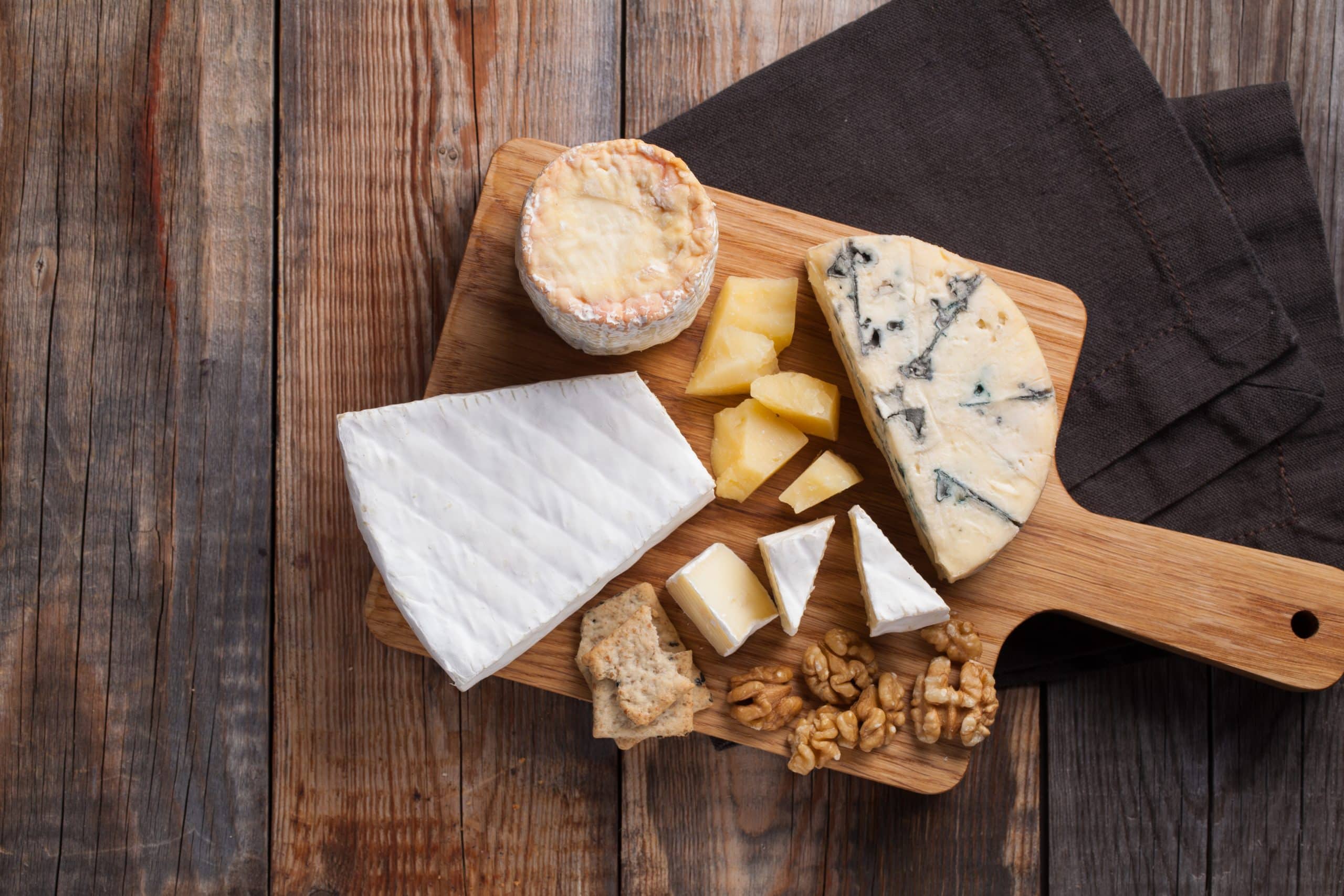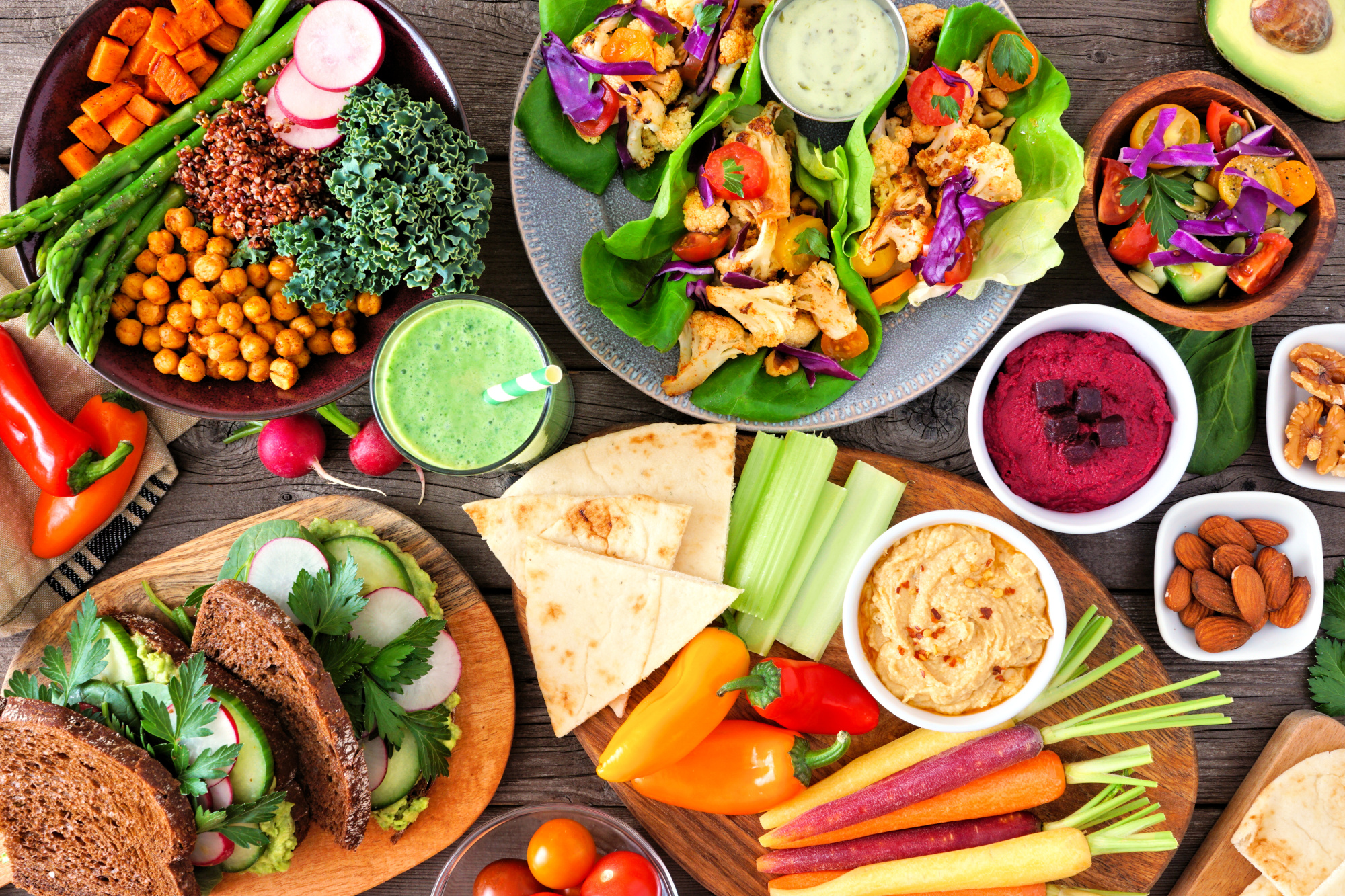Introduction
It is no big secret that people love cheese. For many non-vegans, the popular saying “I would go vegan but…” is often followed by a proclamation of love for cheese. So what is it about plant-based cheese that puts consumers off? And how can your business develop a plant-based-cheese product that overcomes this barrier?
According to Smart Protein’s consumer survey, European consumers consume dairy-based cheese more often than any other animal-derived product other than milk, with 47% consuming cheese more than four times a week.1 Moreover, in 2021, the global plant-based cheese market was valued at 2.43 billion USD and is expected to expand at a CAGR of 12.6% from 2022 to 2030.2
Along with the fact that almost 30% of European consumers are looking to reduce their dairy consumption, it’s clear that flexitarian consumers present a huge potential market for plant-based-cheese products.3

Cheese is a much-loved product throughout Europe – how can the plant-based industry tap into this huge demand?
We’ve spoken to several experts in the field of plant-based cheese and developed four key strategies that your business should employ if you’re looking to develop a plant-based cheese that attracts the widest consumer base possible. These include:
- Focusing on developing great-tasting and pleasingly textured products
- Promoting familiarity by highlighting utility
- Getting your product in front of consumers
- Being careful with labelling and regulations
Overall, the most effective way to target flexitarians – according to our plant-based cheese experts – is to promote familiarity. This doesn’t mean your product needs to taste or look exactly the same as dairy cheese, but it at least needs to be clear that the product can be used in a similar way. Read on to find out more…
1. Focus on developing great-tasting and pleasingly textured products
When asked about the likelihood of purchasing plant-based cheese regularly if it had the same taste and texture profile as dairy-based cheese, over half (52%) of consumers said they were either extremely, very, or moderately likely to purchase the plant-based option.4 Clearly, taste, texture and familiarity are important to consumers – especially to flexitarians who are accustomed to the traditional dairy equivalent.
In order to successfully target flexitarians with any plant-based product, you need to address these key concerns: will the product taste good? And will it have a satisfying texture? The same is true when developing a plant-based cheese .
Swedish brand Peas of Heaven makes plant-based comfort foods, including meat alternatives and two plant-based cheese products made from potato protein and starch. For them, taste always comes first. “We’re trying to appeal to meat eaters, and it’s taste that does that. If the taste is not there, no one will eat it again,” says Julia Granung, Head of Products and R&D.

When appealing to flexitarians, it’s important that your cheese product tastes good on its own and in combination with other ingredients.
For companies looking to target meat-eaters or flexitarians, taste is the first route you should be taking in order to get them on board. This often also means appealing to their sense of familiarity. Flexitarians may turn to plant-based cheese alternatives for a number of reasons, including health, sustainability, and food intolerances, but if it doesn’t taste good, they won’t return for the next purchase. Many are looking for a product similar to what they already recognise as cheese.
Lisa Harrison, Marketing Manager at Norseland, explains how their company’s signature smoky flavouring was essential to the success of their Applewood plant-based cheese alternative. “Consumers know and love our Smoky Applewood flavour.”
Finding the right ingredients to replicate these tastes can be tricky. For plant-based cheese producers, focusing on consumer testing and flavour matching is essential. In order to secure the success of your product, ensure that your company keeps up to date with trends in consumer flavour preferences. You may even want to consider collaborating with companies that utilise AI technologies to predict flavour trends and match consumer preferences – keep an eye on the New Food Hub website for more on this topic at a later date.
Focusing on specific aromatic flavours and ingredients – such as blue mould or smoke – is one way to ensure that your product will appeal to the average flexitarian’s palette. However, many of our interviewees were keen to highlight that plant-based cheeses will never taste like dairy cheeses, because, well, they aren’t dairy.
According to Adam Williams, General Manager at artisanal plant-based cheese company Tyne Chease, attempting to replicate a specific kind of cheese sets flexitarian consumers up for disappointment. Instead, you want to make a product that stands out in its own way and tastes delicious in its own right. It may share similarities to dairy versions, but this should not be the full extent of your plant-based cheese’s identity.
Plant-based cheese is all about managing consumer expectations.”
If you want to know more about how best to replace traditional animal-based ingredients in your products, make sure to watch ProVeg’s webinar ‘Lessons learned from brands who veganised classic products’ on the New Food Hub website. However, taste is not the only factor to consider when making a plant-based cheese. The product also has to be functional and provide consumers with real utility.
2. Promote familiarity by highlighting utility
Many non-vegan consumers are put off by products loudly proclaiming that they’re vegan, making people feel as if the product is not made for them. They may also feel confused, especially by products which, due to restrictive regulations, cannot necessarily call themselves cheese. Aside from focusing on taste and texture, companies can also provide flexitarians with confidence by clarifying its exact uses and advertising cheese-like functionality.
For Applewood, the meltability of their plant-based cheese is central to its success. With many plant-based cheeses on the market being dubbed as plasticky or only usable as slices or in grated form, having a plant-based alternative that melts is a key USP for Norseland.

Applewood’s key USP on their popular vegan cheese product is its meltability.
Similarly, artisanal plant-based cheese companies like Tyne Chease use a host of cheeseboard imagery on their website and social media channels in order to get their flexitarian consumers excited. According to Adam Williams, “It’s a balance between representing the same utilities while not trying to be anything else.” Just as tofu or lentils might replace meat as a protein source in any given dish without trying to be meat, these plant-based cheeses are not trying to be exactly like cheese, even if their purpose in a dish is the same.
According to Vera Tinkova, Founder and CEO of artisanal plant-based cheese company Cheese the Queen, new tastes can be challenging for some consumers who are new to plant-based eating. To solve this problem, you need to get the flexitarian consumer excited by all that your product has to offer. “It’s easier to market to vegans because they know what to do with the products,” she says. “For flexitarians, you need to make it clear exactly what they can do with it and what sort of recipes they can prepare it with, because they might not otherwise know.”
Vera also highlights convenience as a key aspect of marketing plant-based cheese. If a product can be marketed as a way to increase the taste, creativity, health, and sustainability of any given meal in a quick and easy manner, flexitarians will be intrigued. By highlighting the functional aspects of the a – such as meltability – and providing interesting recipes that spark inspiration in the consumer’s mind, potential purchasers are able to imagine for themselves how they might enjoy the product.
If you want to know more about how to embed this sort of convenience into your plant-based products, make sure to watch ProVeg’s webinar on the topic by clicking here.

Demonstrating to flexitarians what you can do with the plant-based cheese – such as melting it on a toastie – is an essential part of successfully marketing your product.
3. Get your product in front of the consumer
Even if your product tastes good and has great utility, consumers won’t buy it if they can’t find it. They might also have more general reservations about plant-based food that your product will have to overcome. After all, 48% of consumers still wouldn’t purchase plant-based cheese even if it had the exact same taste and texture profile as dairy cheese.5
The plant-based-cheese sector has come leaps and bounds in the past few years, and it’s time to help consumers to understand this. Part of this can be done through clever marketing. For example, plant-based cheese company Violife recently released a TV commercial with the tagline ‘Change your Cheese’.6 The advert highlights all of the different ways consumers can cook with Violife, such as melting it on a pizza and using their feta in a Greek salad. Highlighting these qualities in a plant-based cheese is essential, and advertising is a great way to get the word out.
However, as with any food, there is only so much you can achieve through media channels. Consumers need to try the product for themselves.
It’s important to nurture curiosity in consumers and to promote awareness of your product.”
Many of the artisanal plant-based cheese companies we spoke to sell their products at local food markets, where curious non-vegan consumers will often be happy to sample their non-dairy alternatives. In addition to markets, retail shows and trade fairs are also key locations to get your product in front of both consumers and retailers.
MozzaRisella is an Italian plant-based cheese alternative made from germinated brown-rice sprouts. We spoke to UK Operations Manager, Stefano Zanatta, who affirmed that trade shows and cooking demonstrations are essential to convincing consumers of the virtues of your product. “Get your ingredients right and get your products right. Then you just have to invite people to try it.”

Food markets are a favoured location for many small companies hoping to get their plant-based-cheese products in front of consumers for the first time!
Another savvy way to market your plant-based-cheese product is to collaborate with social-media influencers, many of whom have huge vegan and flexitarian followings. If you’d like more information on how best to reach consumers with these taste marketing strategies, as well as many others, click here to read the full article, ‘Five ways to reach consumers through taste marketing’ on our New Food Hub.
Focus on price parity wherever possible
Another key factor that puts flexitarian consumers off buying plant-based cheeses is that they are typically much more expensive than their dairy counterparts.
For plant-based cheeses made with fermented cashews, the high price of the nuts per kilo is a major barrier in achieving price parity with dairy cheeses. At the same time, many artisanal varieties are hand-made and sold with small profit margins. Many of the companies we spoke to were not willing to sacrifice the quality and clean-label aspect of their product in order to scale up production.

Plant-based cheese ingredients such as cashews typically come in at a much higher price point than dairy-based cheese ingredients.
Strictly Roots Vegan is a UK-based company that specialises in artisanal plant-based cheeses made from fermented cashews. CEO and Founder, Angelica Ashcroft, emphasises the importance of producing a high-quality, sustainable product in spite of the price differential. “We pay our employees a living wage, we use organic ingredients where possible, we avoid buying bulk ingredients wrapped in plastic, we make things by hand – of course, it’s going to be expensive,” she says.
She believes that many consumers are happy to pay this price differential once they understand the reasons behind it, just as people are happy to pay a higher price for speciality dairy cheeses. If your company is looking to produce hand-crafted, special-occasion plant-based cheeses destined for the cheeseboard, making your target consumer aware of all the health and sustainability benefits of your product is central.
However, for non-artisanal plant-based cheeses – especially those made with alternative ingredients such as coconut or soya – there are more ways to achieve price parity, thus making your product more attractive to flexitarian consumers as the cost-of-living squeeze hits.
The main strategy is to invest in technology in order to scale up production. For smaller businesses and startups, this is obviously easier said than done – which is why it’s important to seek out collaborations with larger companies and major supermarket retailers. Across Europe, there is certainly sufficient demand for further plant-based cheese expansion, especially beyond the sliced and grated variations currently on supermarket shelves. In Germany, for example, sales of plant-based-cheese products in supermarkets grew from €17 million in 2018 to €44 million in 2020, an increase of 150% that is only expected to keep on growing.7
It’s incredibly expensive to implement the technology needed to expand production. Companies would need major investment and a deal with supermarkets in advance in order to do this.”
If you’d like to know more about achieving price parity for plant-based products in general, with further detail on the topic of lobbying and tax reform, click here to read ‘3 ways to achieve price parity and drive sales’ on the New Food Hub.
What about cultured dairy?
When asked about the future of the plant-based cheese sector, many of those we spoke to highlighted the fast-developing cultured-dairy sector. Although not strictly plant-based, it is nevertheless a sector which has the potential to totally transform the cheese industry and provide similar benefits to plant-based analogues.
Currently, plant-based-cheese brands are struggling to replicate the exact functions of dairy cheese, especially with regards to milk proteins such as casein – an issue that would be totally resolved with cell-cultivation and fermentation technology.
To produce animal-free milk proteins in this manner, the respective genetic information is introduced into a culture of microorganisms, such as fungi or yeast. This culture is then grown in controlled fermentation tanks until sufficient proteins have been produced. The proteins are then harvested by separating them from the microorganisms. The resulting cultured-milk proteins are identical to conventionally produced milk proteins and can be used to manufacture a wide range of delicious dairy products.

A simplified illustration of how cultured dairy products are developed.
There are many startups working in this space – including cultured-dairy firms Formo and Remilk, both of whom are alumni of the ProVeg Incubator. If you’d like to read more about Formo’s experience and their goals as an animal-free dairy company in the cellular-agriculture space, click here to access ProVeg’s article, ‘Cracking the cheese code – the potential of precision fermentation’.
Many consumers are currently opting for ingredients lists that are shorter, easier to understand, and with as few additive ingredients as possible.8 These so-called ‘clean label’ products are often difficult to find within the plant-based cheese industry, with many plant-based products using different types of additives and preservatives in order to mimic dairy-based cheese. New culturing and fermentation techniques present an opportunity for companies to maintain a cleaner label with as few preservatives and additives as possible, while also allowing for greater control over allergens.
It is still very early days for the sector, however, and we have yet to see any products go to market in Europe, partially due to the need for regulatory approval (see below). Your business should keep a keen eye on this space and consider investing in cultured dairy, as it looks set to rapidly expand over the coming years.
4. Be careful with labelling and regulations
Finally, if you are considering launching a plant-based-cheese product targeted at flexitarians, you must consider the legal hurdles involved, especially with regard to product naming and labelling.
The recent blanket ban on plant-based cheese across Turkey is a good example of the sort of discrimination faced by producers of plant-based cheese alternatives, which are facing numerous challenges posed by such restrictions.9 In 2013, the European Parliament banned vegan products from using the terms ‘milk’ and ‘cheese’, meaning that companies must use alternative approaches to labelling their products in order to avoid facing legal challenges.10
According to our interviewees, when they invoke terms similar to cheese in relation to their products – for example by labelling them as ‘Sheese’, in the case of Bute Island Foods – this is mainly as a placeholder for consumers’ comprehension, rather than a strict definition of the category as a whole. As we have already explained, flexitarian consumers need to know what to do with the product and how to use it, and using terms which are similar to cheese achieves this nicely while successfully avoiding regulatory problems.
Angela Chou, Director and Founder of UK-based artisanal cheese brand I Am Nut OK, agrees: “It would be more confusing for consumers to label our products as ‘cultured blocks resembling dairy’, even if this is technically more accurate.”

Be careful! If it looks like cheese, tastes like cheese, and behaves like cheese, it still might not be legally classified as cheese…
In this situation, being creative is key. However, you need to be careful when using puns or wordplay to circumvent the regulations. This is especially true if your company is trying to invoke cheeses of protected regional areas. If you are unsure whether your re-imagining of the terms infringes on regulations, it’s best to seek legal counsel or find different ways to attract consumers with your product name.
Aside from labelling regulations, you also need to be aware of allergens in the production and labelling processes. Many non-vegan consumers may turn to plant-based cheese alternatives due to milk allergies or other intolerances. Ensuring that your product is made in a separate facility or with thorough cleaning processes in place means that your product will be accessible to as many consumers as possible. If this is not feasible, for example, due to costing constraints, all products must be properly labelled. A note on the back-of-pack which states that your product ‘may contain traces of milk’ will allow allergy-sufferers to know that your product is not for them, while those with lactose intolerances might still be able to consume your product.

Consumers with allergies or intolerances need to know what’s in your product. Clear labelling and adjusting your manufacturing processes is essential if you want to avoid any trouble further down the line.
The same rule goes for plant-based cheese products made with allergens such as nuts or soya. Providing flexitarian consumers with a wide range of plant-based cheeses made with different base ingredients means that you can expand your potential customer base. Furthermore, investing in the R&D process will allow your business to discover new ingredients with fewer allergen risks and different functionalities.
Key takeaways
If your business is looking to develop a plant-based-cheese product, there are four key strategies you can employ to target flexitarians and enjoy higher profit margins. These are:
- Focus on developing great tasting and textured products
- Promote familiarity by highlighting utility
- Get your product in front of the consumer
- Be careful with labelling and regulations
While research shows the high level of demand for ‘holy grail’ cheese products such as cheddar and mozzarella, the market for these products is quickly becoming saturated.11 You will want to consider how you can either improve on the current offerings – for example, by investing in new ingredients and technologies – or develop a new cheese analogue for an equivalent that is currently not widely available to consumers, such as halloumi. When people say that they “could never give up cheese”, it is likely these luxury products that they are referring to.
In general, the plant-based-cheese sector is still in its infancy compared to the conventional dairy sector. If the past five years are anything to go by, though, the coming years will be brimming with innovation and novelty. In an ideal world, plant-based cheese alternatives will be able to achieve a similar cultural ‘coolness’ as plant-based milks such as oat and almond have done in the last few years.
In the words of MozzaRisella’s Stefano Zanatta, in order to stand out in the plant-based-cheese sector, “You need to be a little bit daring. You need to try something new and something exciting.”If you’re interested in finding out more about the future of the plant-based sector and would like to access webinars with industry experts, up-to-date case studies, and informative articles, make sure to sign up for ProVeg’s New Food Hub today.
Note: ProVeg conducts exclusive interviews with a wide range of industry professionals for its New Food Hub white papers. Unless an alternative citation is provided, quotations are from those interviews. Some interviewees wished to remain anonymous.
References
- Smart Protein Project (2021): ‘What consumers want: A survey on European consumer attitudes towards plant-based foods. Country-specific insights’ European Union’s Horizon 2020 research and innovation programme (No 862957). Available at: https://smartproteinproject.eu/consumer-attitudes-plant-based-food-report/ Accessed 2022-07-26
- Grand View Research (2021): Vegan Cheese Market Size, Share & Trends Analysis Report By Product, By Source, By End Use, By Region, And Segment Forecasts, 2022-2030. Available at: https://www.grandviewresearch.com/industry-analysis/vegan-cheese-market Accessed 2022-07-26
- Smart Protein Project (2021): ‘What consumers want: A survey on European consumer attitudes towards plant-based foods. Country-specific insights’ European Union’s Horizon 2020 research and innovation programme (No 862957). Available at: https://smartproteinproject.eu/consumer-attitudes-plant-based-food-report/ Accessed 2022-07-26
- Smart Protein Project (2021): ‘What consumers want: A survey on European consumer attitudes towards plant-based foods. Country-specific insights’ European Union’s Horizon 2020 research and innovation programme (No 862957). Available at: https://smartproteinproject.eu/consumer-attitudes-plant-based-food-report/ Accessed 2022-07-26
- Smart Protein Project (2021): ‘What consumers want: A survey on European consumer attitudes towards plant-based foods. Country-specific insights’ European Union’s Horizon 2020 research and innovation programme (No 862957). Available at: https://smartproteinproject.eu/consumer-attitudes-plant-based-food-report/ Accessed 2022-07-26
- Violife Foods (2021): Violife | Change your Cheese. Available at: https://www.youtube.com/watch?v=kilMgJ3rHUE Accessed 2022-08-04
- Future Grocery Shopping (2021): The Plant-based Cheese market in Germany. Available at: https://www.futuregroceryshopping.com/blog/the-plant-based-cheese-market-germany Accessed 2022-08-05
- Brand Essence Research (2022): Clean Label Ingredients Market. Available at: https://brandessenceresearch.com/food-and-beverage/clean-label-ingredients-market Accessed 2022-08-18
- Southey, F. (2022): Plant-based peynir? Production and sale of ‘vegan cheese’ outlawed in Turkey. Food Navigator. Available at: https://www.foodnavigator.com/Article/2022/07/12/Turkey-bans-production-of-vegan-cheese# Accessed 2022-08-05
- European Parliament (2013): Regulation (Eu) No 1308/2013 Of The European Parliament And Of The Council. Official Journal of the European Union. Available at: https://eur-lex.europa.eu/LexUriServ/LexUriServ.do?uri=OJ:L:2013:347:0671:0854:EN:PDF Accessed 2022-08-17
- Smart Protein Project (2021): ‘What consumers want: A survey on European consumer attitudes towards plant-based foods. Country-specific insights’ European Union’s Horizon 2020 research and innovation programme (No 862957). Available at: https://smartproteinproject.eu/consumer-attitudes-plant-based-food-report/ Accessed 2022-07-26



